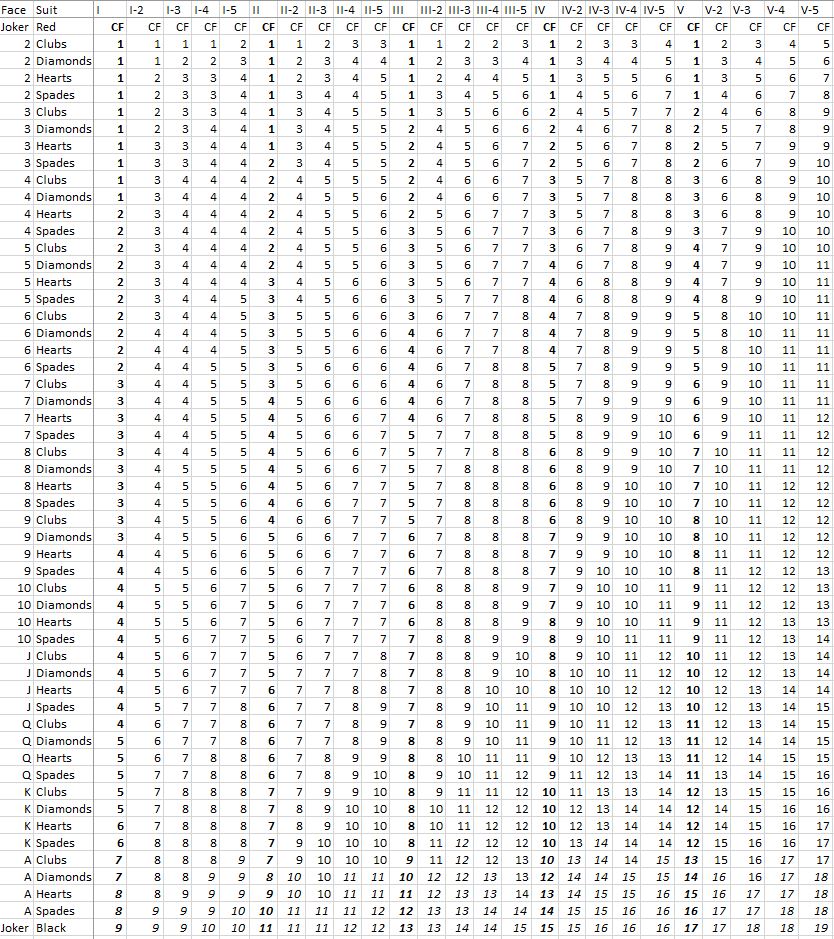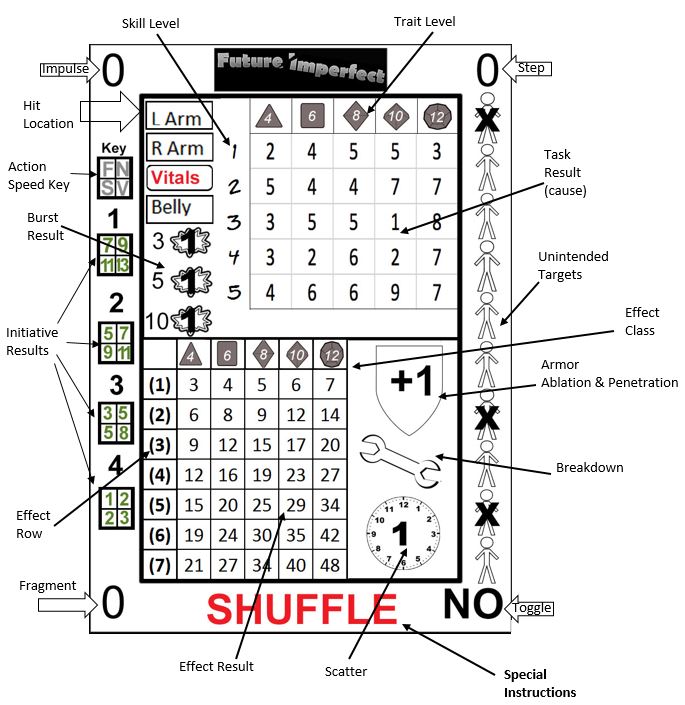Future Imperfect Appendix: 1
Contents
Action Decks
The core of the system revolves around Action Decks. An action deck consists of 54 cards, like a standard playing card deck with the jokers included. Each card has a set of values arranged in a standard order. If a Future Imperfect Action Deck is not present, a standard set of playing cards can be substituted. Please consult the following table for how to read the card.
What is listed above is one section of the Action Card, which should demonstrate the power of the card deck. By combining the results in this manner, a single card draw can simulate up to 12 separate dice rolls, and with easy visual references can make the rules for even very complex situations easy to digest and remember.
Results
Action decks are crafted to be capable of producing many types of results from a single card. Before drawing, the Master will tell you which sections are relevant for the task at hand, once you know the particulars draw a card and consult the results. It's that simple.
Action Cards as Timing
In combat, each round is divided into 15 steps, from 0-14. In general there are 13 steps, but two "special" steps (0 and 14). When actions are rushed or delayed, this change in timing is in steps. When two actions happen during the same step, the higher fragment happens first.
Some actions (such as aiming) are delayed. The action begins when the card is played, and ends when the specified number of steps have passed and the actor has an action card to play.
Actions Cards as Extras
To be filled at a later time.
Action Decks: Under the Hood
Role playing games have been around a long time, and for the vast majority of that time, and for the vast majority of games, dice have been the preferred method of randomization. Dice are simple to understand. Just about anyone can pick up a polyhedral die, roll it, and get the appropriate number.
As an aside, clearly I am not just about anyone. Much less, in fact. When I first got a Dungeons and Dragons boxed set the d4 so mystified me that I intentionally left it at a friend's house so I never had to worry about how to read it. Looking back, I bet there were instructions in the manual for reading the dice properly, but, as previously mentioned, I was the least common denominator.
Using action cards takes a little bit of exposition. However, once the concept is grasped task resolution, both in and out of combat, becomes significantly faster, even while also increasing the scope of play. This was the goal of using action cards: make the game easier to run, even with a higher level of detail.
Card Map
Cards vs Dice: Celebrity Deathmatch
Lucky for all of us, there is no actual death at stake. The cards are created to not simulate dice exactly (for if that was all we wanted, how much is gained?), but to instead extend them into more than they are now.
You may have surmised what the Skill columns mean. I-V are d4-d12 exploding dice, with compounded results, displaying the highest result from any single die (the rows are number of skill levels, which are the number of that die rolled in the sample). However, when rolling an exploding die, it is impossible to achieve the highest number on the die face. If you roll an exploding d6, there is no way to actually get a 6 on a skilled check (6+6+1 would round to 6 in an unskilled check), since another die is rolled and added. Certainly a set of conditions could be devised by which new dice would be rolled on a case by case basis, but this just introduces unnecessary rules and bogs down gameplay. Instead, the appropriate average value for each die type is calculated, and a set of values is generated across the card base to achieve a "fair" result (exactly equal to the average in aggregate).
Another dice extension is the inclusion of die types that do not exist. Cards can easily simulate a d14.
Sequencing
One challenge when creating an action deck is determining which sets of values can be grouped together, and which must be randomized separately. You cannot put all the high damage results on the same card as the high hit results, for example. If you did, why have a separate damage calculation at all? It might as well be a single result. The same is true of hit location.
An argument could be made that greater skill would lead to greater damage as well as better shot grouping. If this is your desire for your game, a deck that simulates this can easily be created. In this case, the rule of moving hit location based on bumps needs to be removed to compensate.
Action cards are aware of the combat sequence. They "know" how to perform each rule accurately. Consult the appropriate row and column to see if you hit, consult the rounded rectangle for where, then bump as appropriate. Consult the appropriate row and column for damage, adjusted, if necessary, for hit location. Check the burst with the correct number to see if multiple rounds hit. If some rounds that were fired did not hit the target, check the row of untargeted bystanders to see if any are hit. Check for armor ablation and breakdown in the areas near damage. If the shot was a miss, use the clock face to see where the errant shot went.
What happens on a card is it generates every possible necessary die roll, and you just use the ones you need. No consulting books or tables, everything is there with the rules already figured. In Future Imperfect, the action cards truly are the game engine.
Ability Decks
Ability decks are specialized action decks for certain abilities or mini-games, such as Martial Arts or Psionics.

